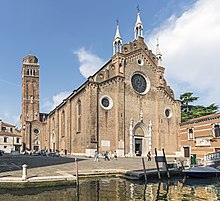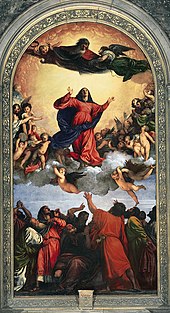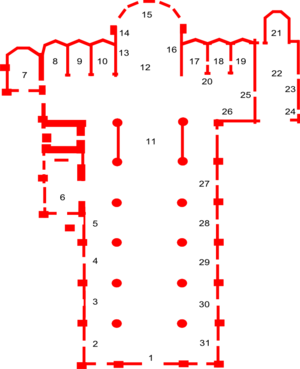Santa Maria Gloriosa dei Frari
Santa Maria Gloriosa dei Frari , also Frari Church or Frari for short ( Venetian "Brothers"), is next to San Zanipolo the largest and most important Gothic sacred building in Venice . The Roman Catholic Church is located on Campo dei Frari in the Sestiere of San Polo and is dedicated to the Patronage of the Assumption of Mary into Heaven . It is equipped with numerous outstanding works of art, including two major works by Titian, and houses numerous grave monuments by famous Venetians, including Titian. In 1926 she received the honorary title of papal basilica minor . The Venice State Archives have been located in the two former monasteries belonging to the church since 1817 .
History and building history
Around 1223 the Friars Minor of the Franciscans settled in an existing monastery building on the edge of the urban development at that time. There they began around 1250 with the construction of a small church consecrated to Our Lady , the Santa Maria de 'Frati Minori , ("Santa Maria of the Minor Brothers"), which was consecrated in 1280 . In 1340 this 40-meter-long church was demolished to make room for a new building, as it soon became too small due to the large number of visitors to the sermons of the brothers. In 1361 the apse and transept of the now south-west facing church were consecrated and the construction of the campanile, completed in 1396, began by the builders Jacopo and Pierpaolo Celega. In 1420, by order of Marco Corner, the father of the future Queen Caterina Cornaro , the Capella Corner was added southwest of the Milanese chapel. It is consecrated to the patron saint of its client, Saint Mark , and houses a triptych created by Bartolomeo Vivarini with Saints Mark, Jerome , Peter , Nicholas and John the Baptist . To the south of the side aisle, the Cappella Emiliana, consecrated to St. Peter, was built between 1432 and 1434, a baptistery that was used as a burial place by the donors, the Emiliana family . Both chapels each have a portal to the Campo dei Frari. In the middle of the 15th century, the sacristy was built as a separate building in the north transept . In 1468, the church received its choir screen decorated with fourteen reliefs in the yoke in front of the crossing , on which Bartolomeo Buon is said to have worked. In the same year the carved choir stalls were completed. The facade was completed towards the end of the 15th century. On May 19, 1518, the altarpiece of the Assumption of the Virgin by Titian was installed above the high altar .
Scuola Grande di San Rocco
To the west of the Frari Church are the church and house of the Brotherhood of St. Rochus, the Scuola Grande di San Rocco . Tintoretto's works are located here . Before the fraternity received a piece of land from the Franciscan friars of the Frari church in 1489 to build their scuola, it was located in the monastery of the Frari church.
architecture
The simple, three-part late Gothic main facade of the brick building with pilaster strips is adorned with a richly staggered and curved gable. The decorative elements such as the frame of the rose window , the oculi , the friezes , the wreath-like cornice end and the three aedicules of the facade end as well as the portal, crowned with statues of the Savior by Alessandro Vittoria (1581) on the central tip, St. Francis and a Madonna with the child from the workshop of Bartolomeo Bon on the side pegs are made of Istrian stone . The large central rose is also made of red Veronese stone. The stone-looking vault was built from plastered cane to reduce weight because of the problematic subsoil. As with other Venetian churches, the structure is stabilized by wooden tie rods. The church is almost 80 m long and 30 m wide.
The Frarikirche is a three-aisled pillar basilica with a single-nave high transept and a group of six small and one large central choir chapel , all of which have a polygonal closure. To the south-east of the apse are the Milanese Chapel, the Chapel of St. Michael or Capella Trevisan and the Chapel of the Franciscan Saints (Capella di S. Francesco). North-west of the apse are the Baptist Chapel (cappella dei Fiorentini), the Sacramentous Chapel (cappella del Sacramento) and the Bernardo family chapel (cappella Bernardo) with Bartolomeo Vivarini's 1482 painting of the Virgin with Saints Andrew , Nicholas of Bari , Paul and Peter , the at the same time represents the ancestors of the four lines of the Bernardo house and from which, in comparison with the eight years older triptych in the Cappella Corner, the stylistic development of Vivarini can be clearly read. All parts of the room have a ribbed vault .
Furnishing
- Interior facade
- Kreuzkapelle
- Monument to Canova
- Monument to the Doge Pesaro
- Madonna of the House of Pesaro
- Emiliani Chapel or Cappella Emiliana
- Corner Chapel or Cappella Corner
- Milanese or Milanese chapel
- St. Michael's Chapel or Capella Trevisan
- Chapel of the Franciscan Saints (Capella di S. Francesco)
- Choir stalls
- Choir
- Monument to the Doge Tron
- 12th century cross
- Assumption of the Virgin by Titian (and great organ)
- Monument to the Doge Foscari
- Baptist Chapel (cappella dei Fiorentini)
- Chapel of Father Kolbe or Sacrament Chapel
- Chapel of Bernardo
- Pietà
- Sacristy altar and triptych by Giovanni Bellini
- Sacristy with painting Hagar in the desert
- Relic altar
- Entrance to the chapter house and convent of the Frari
- Wall of the right transept
- Monument to Jacopo Marcello
- Altar of Saint Catherine
- Altar of St. Joseph of Copertino
- Altar of the circumcision of Jesus
- Tomb of the painter Titian
- Altar of St. Anthony of Padua
Tombs




The tombs of the following people are located in the Frari Church:
- Wall grave for the Franciscan Beato pacifico , the builder of the Frari Church, around 1437
- Monument to the sculptor Antonio Canova († 1822 ), to keep the urn with his heart, built according to his own design by his students
- Wall tomb for the Doge Francesco Dandolo († 1339 ) with a panel by Paolo Veneziano with depictions of the Doge and his wife Elisabetta Contarini with Saints Francis and Elisabeth of Hungary, chapter house of the monastery
- Canopy grave of Doge Francesco Foscari († 1457 ), right wall of the presbytery , by Antonio and Paolo Bregno
- Honorary monument for General Girolamo Garzoni († 1688 ), around 1700, above the main portal
- Wall grave for Jacopo Marcello by Pietro Lombardo and his workshop, transept
- Claudio Monteverdi († 1643 ), floor grave with grave slab, Cappella Milanesi
- Tomb of Alvise Pasqualino († 1528 ), procurator, attributed to Andrea Bregno , next to the main portal
- Tomb for Admiral Benedetto Pesaro († 1503 ), right aisle
- Tomb for the Doge Giovanni Pesaro († 1659 ), based on a design by Baldassare Longhena , sculptures by Melchior Barthel
- Tomb for the titular bishop and fleet commander Jacopo Pesaro († 1547 ), central nave
- Tomb for the condottiere Paolo Savelli († 1405 ), the first equestrian monument that Venice granted a condottiere
- Tomb for General Melchiore Trevisan († 1500 ), by Lorenzo Bregno
- Tomb for the Doge Niccolò Tron († 1473 ), in the presbytery, by Antonio Rizzo
- Tomb for the painter Titian , donated by Emperor Ferdinand I of Austria , built by two Canova students between 1838 and 1852
Monument to Canova
The monument to Canova goes back to his design for an unrealized grave for Titian and was adapted as a grave monument for Maria Christina of Austria in the Augustinian Church in Vienna . When Canova died in 1822, his body was transferred to his native Possagno and in 1827 the Carrara marble monument was erected in the Frari Church. In front of the open pyramid door to the supposed burial chamber are three female sculptures, the weeping sculpture, the painting and the architecture, followed by three geniuses with lit torches for the immortality of art. On the left is Canova's genius with an extinguished torch and the desperate Lion of Venice. Above the door, two angels carry the sculptor's portrait, which is entwined by a snake as a symbol of immortality.
Paintings and sculptures
- Giambattista Pittoni , Hagar in the desert , around XVIII, sacristy
- Giovanni Bellini : Triptych , 1488 , Pesaro Choir,
- Giovanni Bellini: Madonna with child between the hll. Peter and Nicholas, Benedict and Mark , sacristy
- Girolamo Campagna : statues of St. Agnes and Anthony of Padua , nave
- Donatello : St. John the Baptist, sculpture
- Giuseppe Salviati : Presentation in the temple , around 1560, altarpiece
- Sansovino : St. John the Baptist, statue in front of the Cappella Corner
- Titian : Madonna of the House of Pesaro , 1519–1527, altarpiece, north wall of the central nave, Pesaro chapel
- Titian : Assumption of the Virgin , 1518
- The Assumption of Mary Titian was painted especially for this place and placed above the high altar in 1518. The picture was painted with oil paints on wood in the dimensions 668 × 344 cm.
- Richard Wagner , who saw Titian's picture in 1861 in the Accademia , where it was exhibited in a specially built hall from 1817 to 1921 until it was brought back to the church, was inspired by the sight of this painting for his Meistersinger von Nürnberg .
- Palma il Giovane , Martyrdom of Saint Catherine of Alexandria (1590–1595)
- Paolo Veneziano : Votive image of Doge Francesco Dandolo and Dogaressa Isabetta Contarini with their patron saints Francis and Elisabeth, 1339 , chapter house of the Frari church
- Alessandro Vittoria : The Risen Christ , sculpture
- Alessandro Vittoria: St. Jerome , sculpture
- Alvise Vivarini : St. Augustine and other saints , northern chapel in the transept
- Bartolomeo Vivarini : St. Mark , Altarpiece, Cappella Corner
- Bartolomeo Vivarini: Madonna with Child and Saints , altarpiece, southern chapel in the transept
organ
As early as 1400 the Frari church was equipped with an organ . Today the church has two organs from the 18th century, which are housed on the two singers' stands. The organ on the left podium was built in 1732 by the Venetian organ builder Giovanni Battista Piaggia . The purely mechanical instrument is largely original. It has a manual work with attached pedal (cdefgah-e 0 ) without its own register . The tabs are arranged to the left and right of the gaming table. The organ on the right-hand podium was built between 1795 and 1796 by the organ builder Gaetano Callido . The purely mechanical instrument also has a manual (CDEFGAH – d 3 ). The pedal is attached. During an extensive renovation in the second half of the 20th century, both organs were coordinated and can be played together. The excellent condition of the two instruments enables the music of the 16th and 17th centuries to be performed for two organs.
|
|
|
|
||||||||||||||||||||||||||||||||||||||||||||
- Remarks
- B = bass side
- D = treble side
- P = register only in pedal position
Behind the main altar is a large organ, which was built in 1927 by the Mascioni organ building company . The instrument has 31 stops on three manuals and a pedal. The playing and stop actions are electro-pneumatic.
|
|
|
|
||||||||||||||||||||||||||||||||||||||||||||||||||||||||||||||||||||||
- Coupling: I / I (super octave coupling), II / I, II / II (super octave coupling) III / I (also as sub and super octave coupling), III / II (also as sub octave coupling), III / III (sub octave coupling), I / P , II / P, III / P
literature
- Ennio Concina: Churches in Venice. Art and history. Text by Ennio Concina. Photographs by Piero Codato. Hirmer, Munich 1996, ISBN 3-7774-7010-4 , pp. 190-207
- Herbert Rosendorfer : Church Guide Venice , Leipzig 2008, 2nd edition, EA Seemann, 2013, pp. 31–36.
- Silvia Riboni: La Basilica di Santa Maria Gloriosa dei Frari di Venezia: il turismo tra ottocento e contemporaneità , tesi di laurea, Università Ca 'Foscari, Venice 2016 ( online ).
- Joseph Ungaro OFMConv: The Basilica of the Frari in Venice , 2nd edition 1976, 113 pp.
Remarks
- ↑ CELEGA (Ceilega, cellga), Pier Paolo , in: Dizionario Biografico degli Italiani, vol. 23 (1979)
- ↑ No. 7 of the floor plan
- ↑ a b no. 8 of the floor plan
- ↑ No. 6 of the floor plan
- ↑ No. 22 of the floor plan
- ↑ No. 11 of the floor plan
- ↑ No. 12 of the floor plan
- ↑ No. 9 of the floor plan
- ↑ No. 10 of the floor plan
- ↑ No. 17 of the floor plan
- ↑ No. 18 of the floor plan
- ↑ No. 19 of the floor plan
- ↑ Chorus (Italian)
Web links
- Frari Church website, Italian
- Basilica dei Frari leaflet
- Chorus Venezia, Basilica dei Frari (English)
Coordinates: 45 ° 26 ′ 12.2 " N , 12 ° 19 ′ 33.8" E








